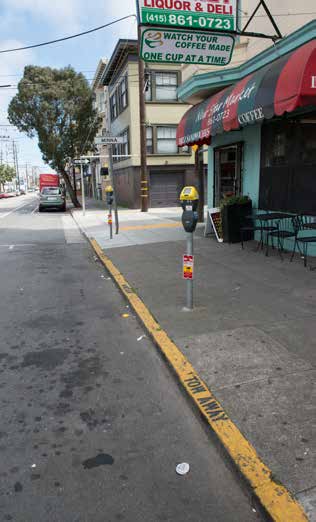Primer for Improved Urban Freight Mobility and Delivery
|
||
Key Accomplishments
|
In many urban areas, particularly business and commercial districts, parking spaces are limited. In San Francisco, trucks that are loading and unloading often double-park, extend onto sidewalks and roadways, or circle city blocks in the hopes of finding a parking space. This can impede traffic flow and result in parking tickets that increase the cost of operations for carriers. Clearly designating when and where freight activities can occur curbside can help manage truck access to designated spaces during peak delivery hours.
The San Francisco Municipal Transportation Agency (SFMTA) manages the "Color Curb" program, which is used to regulate the City's curbside space. Curbs are painted one of five colors to clearly designate which activities can occur at curbside. Yellow zones designate curbside areas used for active freight loading and unloading by commercial vehicles (those with a commercial license plate) during posted times.
The primary goal of the color curb program is to provide sufficient space for both passenger and freight loading and unloading. When passenger and freight loading occurs in the streets without adequate curbside access, it can often result in traffic slowdowns (particularly public transit), increased congestion, and safety risks to bicycles and pedestrians. This is why SFMTA believes that securing space for loading space is more important than space for parking.
Each yellow loading zone varies in length and time depending on the loading needs of the nearby businesses. However, given San Francisco's geography, topography, and density, most curbside loading zones cannot accommodate semi-trailers or other large vehicles. Loading zones also have specific posted hours of permitted usage. Hours generally vary, but most end by 6:00 p.m. in order to open to non-commercial vehicle parking.
The color curb management has been active and evolving in San Francisco since the 1930s. Over the years, it has been managed by various City agencies, including the Public Works Department, Traffic Engineering Department, San Francisco Police Department, and, since the early 2000s, SFMTA. For non-freight loading zones, SFMTA works closely with personnel from other departments within the agency, such as Transit Engineering, to expand lengths of passenger loading zones and hours where appropriate. For freight loading zones, SFMTA relies on businesses to tell them if a loading zone is insufficient. In addition, SFMTA relies on residents and businesses to notify them of unused loading zones that may be better used for parking.

Color curbs in San Francisco. Source: SFMTA.
The SFMTA Parking Enforcement Department strongly enforces the color curb regulations, and will often tow or cite non-commercial vehicles parked in yellow loading zones during effective hours. The SFMTA and the Police Department also issues citations for double-parked vehicles, which is typically considered a "cost of doing business" by carriers. To further improve compliance, SFMTA is looking at other ways to further reduce double-parking.
Public hearings are held monthly at City Hall to discuss the installation of new color curb zones, enabling the public to comment on any proposed changes to City streets. SFMTA processes roughly 80 color curb requests for per month about a dozen of them are related to commercial loading, and regularly makes improvements to existing loading zones to better suit the needs of businesses and residents. SFMTA keeps records of all loading zones, and tracks customer satisfaction and response time to requests for loading zones. SFMTA is also considering altering the yellow loading zone vehicle requirements to accommodate certain non-commercial vehicles, such as those making food deliveries and those carrying smaller packages. Instead of restricting non-commercial vehicles carrying freight, SFMTA actively looks for new techniques to support these deliveries to improve urban freight mobility.
Paul Kniha, Color Curb Program Manager, SFMTA, (415) 646-2465, Paul.Kniha@sfmta.com
|
United States Department of Transportation - Federal Highway Administration |
||